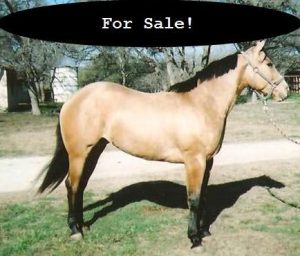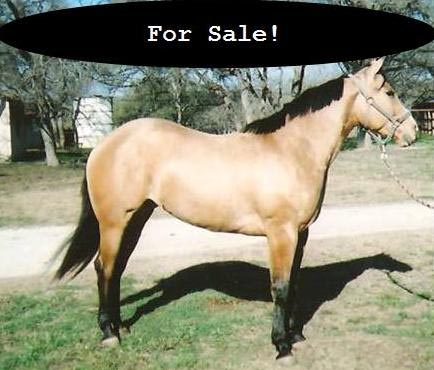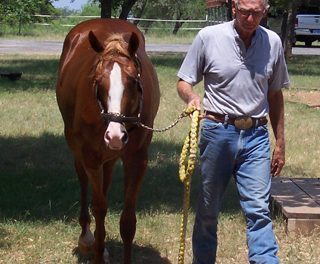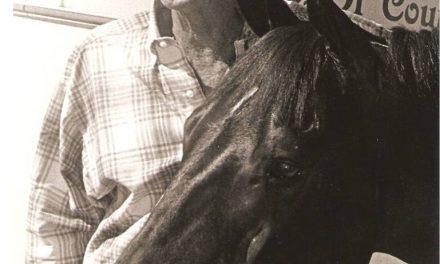A Horse, Of Course
 When it comes to buying a horse, there must be at least a million ways to get stuck with a bad one and about five ways to get a good one.
When it comes to buying a horse, there must be at least a million ways to get stuck with a bad one and about five ways to get a good one.
To get a good horse, you have to use a little common sense. Emotion is the villain.
It’s natural to be excited by the thrill of owning a new horse. But, whoa! Hold on! Shorten the reins!
I know the horse is beautiful and the story that goes with the horse is reasonable and the horse may be sold tomorrow, but accept some hard-to-take advice. Buyer, beware!
Before you start looking for a horse, decide what you want and write it down. Your list should include breed, size, age, amount of training, color, sex and price. You’re the only one who knows exactly what you want and you’re the one who must be satisfied.
Don’t let emotion cloud your view. The horse you buy should meet all your requirements or you’ll be unhappy later.
Think about your physical relationship with the horse. Is he too big, or too small? As a team do you look well together?
A good horse doesn’t cost a dime more to keep than a bad one. In many cases the better horse will be less expensive in the long run.
Bargain horses usually are not bargains, so beware of sad stories, auctions and the fast deal.
Well-known trainers are most often the best place to start looking for your new horse. They have a reputation to protect and generally will not leave you stuck with a bad horse. A bad horse can hurt a trainer’s reputation in a hurry.
So now that you know what you want and you have a good place to start looking, here are five tests and some common sense.
Test one – look at the person selling the horse. Is he or she neatly dressed? They don’t have to be in their Sunday best, but they should be neat, clean and ready to meet you.
The ranch or facility should well-kept, too. The barn area should be neat, clean and tidy. Equipment should be well cared for and in the proper place. Broken tools, broken fences and sloppy barns is a clue the owner cares for his horses in the same manner.
Look at the stall or corral in which the horse is kept. Wood chewers and cribbers leave telltale signs. As do weavers and hole diggers. Bad habits are hard to break.
Test two – look at the horse’s conformation.
If possible, ask to see the horse work at liberty in a safe paddock or arena. See how the horse uses his body. Notice how the horse interacts with people. He should be friendly, curious and have clear bright eyes. He shouldn’t be jumpy.
I like to see a horse in good flesh, but not overly fat. Look for clean legs, free from blemishes, and smoothly put together body.
The conformation should be of the type required for the discipline in which you are interested. His conformation should be pleasing to you.
Test three – is the horse’s performance ability and training at the level you require?
Of course, if you are looking at an unbroken youngster, you won’t be able to ride him. But you can review his pedigree, watch the way he travels and take notice of his manners.
If the horse can be ridden, ask the owner or trainer to ride the horse and show you how well he performs. This also gives you an opportunity to make a determination based on how the owner or trainer handled the horse.
If the rider is not accomplished, chances are the horse had a bad start and you face some re-schooling.
If the rider jerks, bangs, spurs and hits the horse – pack up and move on. You don’t want that bundle of trouble.
Now it is your turn to ride. The secret of a test ride is to see how slowly the horse will perform and how responsive he is to your cues.
Walk the horse, stop him, back him, jog him, stop him, lope him, and stop again. Change gaits frequently and take notice of the horse’s attitude about work. If he works quietly and slowly, if he changes gaits without getting high or nervous, if he listens and responses to your cues, he passes.
Test four – the vet check. Don’t fail to have a soundness examination.
Test five – the price. A horse is worth what someone is willing to pay. Usually you can get the horse for a little less than the asking price. If so, fine. If not, and the horse is the one you want, pay the price. But if a deal is offered to you suddenly, watch out. An anxious seller is a bad sign.
And, finally, this word of advice: don’t be afraid to buy the first horse you look at or the tenth, if the horse passes all your tests.
Along the way you’ll hear some great stories about some flashy horses, but don’t change your list or requirements. Somewhere your horse is waiting.
Once you have your dream horse, enroll and take the online equine courses at Equine Studies Institute. Work one-on-one with instructors. Earn certificates upon completion. http://www.equinestudiesinstitute.com/




